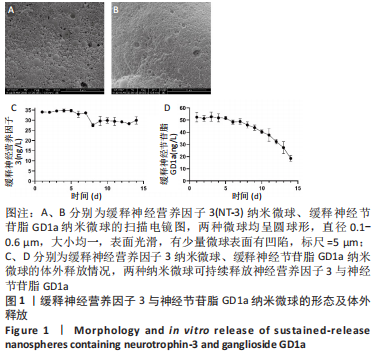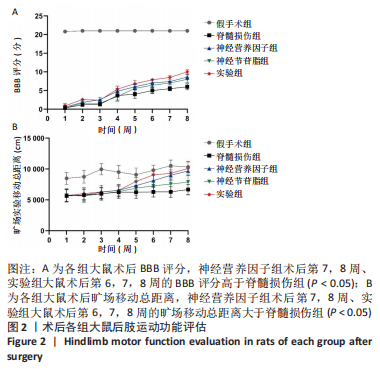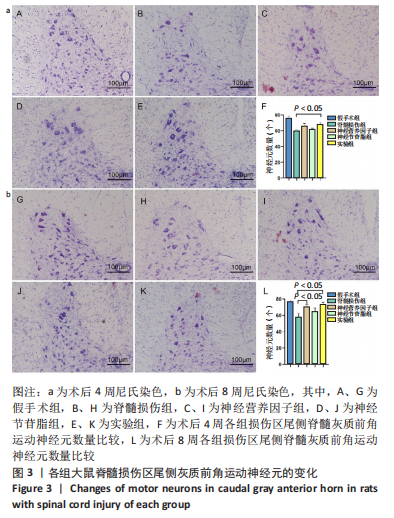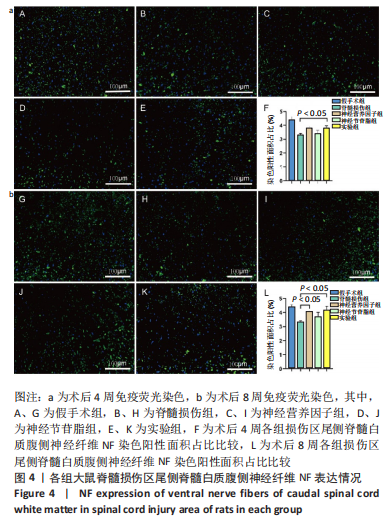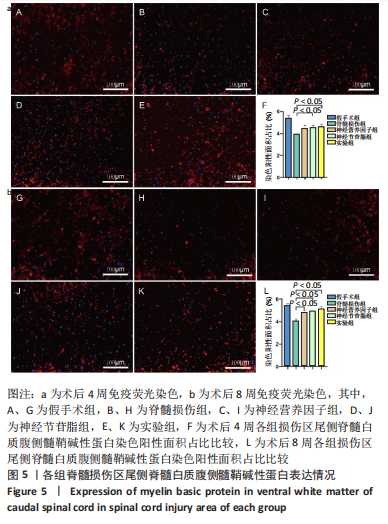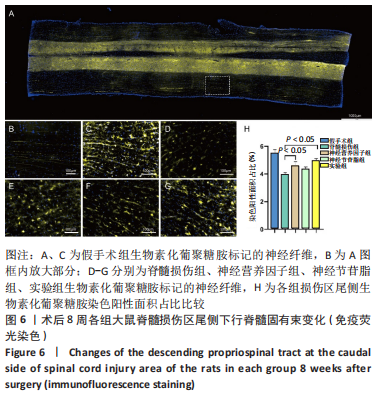[1] GUO S, REDENSKI I, LANDAU S, et al. Prevascularized Scaffolds Bearing Human Dental Pulp Stem Cells for Treating Complete Spinal Cord Injury. Adv Healthc Mater. 2020;9(20):e2000974.
[2] SHI B, DING J, LIU Y, et al. ERK1/2 pathway-mediated differentiation of IGF-1-transfected spinal cord-derived neural stem cells into oligodendrocytes. PloS One. 2014;9(8):e106038.
[3] YANG B, ZHANG F, CHENG F, et al. Strategies and prospects of effective neural circuits reconstruction after spinal cord injury. Cell Death Dis. 2020;11(6):439.
[4] GU Y, ZHANG R, JIANG B, et al. Repair of Spinal Cord Injury by Inhibition of PLK4 Expression Through Local Delivery of siRNA-Loaded Nanoparticles. J Mol Neurosci. 2021;72(3):544-554.
[5] BADHIWALA JH, AHUJA CS, FEHLINGS MG. Time is spine: a review of translational advances in spinal cord injury. J Neurosurg Spine. 2019; 30(1):1-18.
[6] YE J, XUE R, JI ZY, et al. Effect of NT-3 on repair of spinal cord injury through the MAPK signaling pathway. Eur Rev Med Pharmacol Sci. 2020;24(5):2165-2172.
[7] MUHEREMU A, SHU L, LIANG J, et al. Sustained delivery of neurotrophic factors to treat spinal cord injury. Transl Neurosci. 2021;12(1):494-511.
[8] HAN Q, XU X. Neurotrophin-3-mediated locomotor recovery: a novel therapeutic strategy targeting lumbar neural circuitry after spinal cord injury. Neural Regen Res. 2020;15(12):2241-2242.
[9] XU Z, ZHANG L, ZHOU Y, et al. Histological and functional outcomes in a rat model of hemisected spinal cord with sustained VEGF/NT-3 release from tissue-engineered grafts. Artif Cells Nanomed Biotechnol. 2020;48(1):362-376.
[10] CHINNOCK P, ROBERTS I. Gangliosides for acute spinal cord injury. Cochrane Database Syst Rev. 2005;2005(2):CD004444.
[11] HE Y, LI J. Ganglioside GD1a inhibits LPS-induced inflammation in types of cells. Int Immunopharmacol. 2016;31:222.
[12] AZZAZ F, YAHI N, DI SCALA C, et al. Ganglioside binding domains in proteins: Physiological and pathological mechanisms. Adv Protein Chem Struct Biol. 2022;128:289-324.
[13] QIN J, SIKKEMA AH, VAN DER BIJ K, et al. GD1a Overcomes Inhibition of Myelination by Fibronectin via Activation of Protein Kinase A: Implications for Multiple Sclerosis. J Neurosci. 2017;37(41):9925-9938.
[14] RAWJI KS, GONZALEZ MARTINEZ GA, SHARMA A, et al. The Role of Astrocytes in Remyelination. Trends Neurosci. 2020;43(8):596-607.
[15] HUANG F, CHEN T, CHANG J, et al. A conductive dual-network hydrogel composed of oxidized dextran and hyaluronic-hydrazide as BDNF delivery systems for potential spinal cord injury repair. Int J Biol Macromol. 2021;167:434-445.
[16] AHI ZB, ASSUNCAO-SILVA RC, SALGADO AJ, et al. A combinatorial approach for spinal cord injury repair using multifunctional collagen-based matrices: development, characterization and impact on cell adhesion and axonal growth. Biomed Mater. 2020;15(5):55024.
[17] 卢仁培,邹志晨,赵丰年,等.聚乳酸-羟基乙酸共聚物复合支架在骨缺损修复再生中的作用与应用[J].中国组织工程研究,2022, 26(28):4525-4531.
[18] YU S, YAO S, WEN Y, et al. Angiogenic microspheres promote neural regeneration and motor function recovery after spinal cord injury in rats. Sci Rep. 2016;6:33428.
[19] JU R, WEN Y, GOU R, et al. The Experimental Therapy on Brain Ischemia by Improvement of Local Angiogenesis with Tissue Engineering in the Mouse. Cell Transplant. 2014;23(1_suppl):83-95.
[20] WEN Y, YU S, WU Y, et al. Spinal cord injury repair by implantation of structured hyaluronic acid scaffold with PLGA microspheres in the rat. Cell Tissue Res. 2016;364(1):17-28.
[21] HAN Q, ORDAZ JD, LIU N, et al. Descending motor circuitry required for NT-3 mediated locomotor recovery after spinal cord injury in mice. Nat Commun. 2019;10(1):5815.
[22] BASSO DM, BEATTIE MS, BRESNAHAN JC. A sensitive and reliable locomotor rating scale for open field testing in rats. J Neurotrauma. 1995;12(1):1-21.
[23] 董瑞,毕燕琳,王明山.旷场实验在鼠行为学研究中的应用[J].国际麻醉学与复苏杂志,2020,41(5):535-540.
[24] WANG J, LI D, LIANG C, et al. Scar Tissue‐Targeting Polymer Micelle for Spinal Cord Injury Treatment. Small. 2020;16(8):1906415.
[25] BADHIWALA JH, WILSON JR, FEHLINGS MG. Global burden of traumatic brain and spinal cord injury. Lancet Neurol. 2019;18(1):24-25.
[26] ZOU Y, MA D, SHEN H, et al. Aligned collagen scaffold combination with human spinal cord-derived neural stem cells to improve spinal cord injury repair. Biomater Sci. 2020;8(18):5145-5156.
[27] MARQUARDT LM, DOULAMES VM, WANG AT, et al. Designer, injectable gels to prevent transplanted Schwann cell loss during spinal cord injury therapy. Sci Adv. 2020;6(14):z1039.
[28] LIU D, SHEN H, SHEN Y, et al. Dual‐Cues Laden Scaffold Facilitates Neurovascular Regeneration and Motor Functional Recovery After Complete Spinal Cord Injury. Adv Healthc Mater. 2021;10(10):2100089.
[29] KWIECIEN J. Barriers to axonal regeneration after spinal cord injury: a current perspective. Neural Regen Res. 2022;17(1):85-86.
[30] LI G, ZHANG B, SUN JH, et al. An NT-3-releasing bioscaffold supports the formation of TrkC-modified neural stem cell-derived neural network tissue with efficacy in repairing spinal cord injury. Bioact Mater. 2021; 6(11):3766-3781.
[31] SMITH DR, DUMONT CM, PARK J, et al. Polycistronic Delivery of IL-10 and NT-3 Promotes Oligodendrocyte Myelination and Functional Recovery in a Mouse Spinal Cord Injury Model. Tissue Eng Part A. 2020; 26(11-12):672-682.
[32] SONG YH, AGRAWAL NK, GRIFFIN JM, et al. Recent advances in nanotherapeutic strategies for spinal cord injury repair. Adv Drug Deliv Rev. 2019;148:38-59.
[33] ZERAATPISHEH Z, MIRZAEI E, NAMI M, et al. Local delivery of fingolimod through PLGA nanoparticles and PuraMatrix-embedded neural precursor cells promote motor function recovery and tissue repair in spinal cord injury. Eur J Neurosci. 2021;54(4):5620-5637.
[34] SANTHOSH KT, ALIZADEH A, KARIMI-ABDOLREZAEE S. Design and optimization of PLGA microparticles for controlled and local delivery of Neuregulin-1 in traumatic spinal cord injury. J Control Release. 2017; 261:147-162.
[35] LOWRY N, GODERIE SK, LEDERMAN P, et al. The effect of long-term release of Shh from implanted biodegradable microspheres on recovery from spinal cord injury in mice. Biomaterials. 2011;33(10):2892-2901.
[36] ZERAATPISHEH Z, MIRZAEI E, NAMI M, et al. Local delivery of fingolimod through PLGA nanoparticles and PuraMatrix-embedded neural precursor cells promote motor function recovery and tissue repair in spinal cord injury. Eur J Neurosci. 2021;54(4):5620-5637.
[37] CONG Y, WANG C, WANG J, et al. NT-3 Promotes Oligodendrocyte Proliferation and Nerve Function Recovery After Spinal Cord Injury by Inhibiting Autophagy Pathway. J Surg Res. 2020;247:128-135.
[38] WANG Y, WU W, WU X, et al. Remodeling of lumbar motor circuitry remote to a thoracic spinal cord injury promotes locomotor recovery. Elife. 2018;7:e39016.
[39] GALLEGUILLOS D, WANG Q, STEINBERG N, et al. Anti-inflammatory role of GM1 and other gangliosides on microglia. J Neuroinflammation. 2022;19(1):9.
[40] LIN Y, LI C, LI J, et al. NEP1-40-modified human serum albumin nanoparticles enhance the therapeutic effect of methylprednisolone against spinal cord injury. J Nanobiotechnol. 2019;17(1):12.
[41] DE MIRANDA AS, DE BARROS J, TEIXEIRA AL. Is neurotrophin-3 (NT-3): a potential therapeutic target for depression and anxiety? Expert Opin Ther Targets. 2020;24(12):1225-1238.
[42] YU Y, LI Z, MA F, et al. Neurotrophin‐3 stimulates stem Leydig cell proliferation during regeneration in rats. J Cell Mol Med. 2020;24(23): 13679-13689.
[43] ELLIOTT DI, TATOR CH, SHOICHET MS. Local Delivery of Neurotrophin-3 and Anti-NogoA Promotes Repair After Spinal Cord Injury. Tissue Eng Part A. 2016;22(9-10):733-741.
[44] MORADIAN H, KESHVARI H, FASEHEE H, et al. Combining NT3-overexpressing MSCs and PLGA microcarriers for brain tissue engineering: A potential tool for treatment of Parkinson’s disease. Mater Sci Eng C Mater Biol Appl. 2017;76:934-943.
[45] MAGISTRETTI PJ, GEISLER FH, SCHNEIDER JS, et al. Gangliosides: Treatment Avenues in Neurodegenerative Disease. Front Neurol. 2019; 10:859. |

